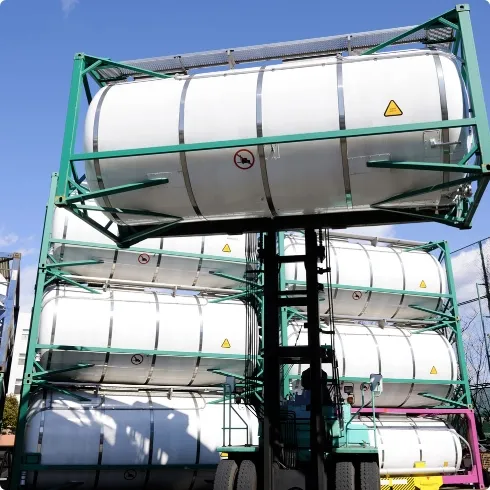
As one of the leading global tank operator, our client faced a significant challenge: how to efficiently reposition thousands of tank containers worldwide without driving up operational costs. Limited visibility, reactive planning, and disconnected global coordination caused costly inefficiencies. Partnering with ICRON, they implemented a strategic, data-driven capacity planning solution, turning their repositioning strategy into a synchronized, priority-based operation with full visibility and fast decision-making. Discover how a global tank operator tackled complexity head-on to optimize tank utilization, cut tank relocation costs, and stay ahead in the competitive world of global logistics.
Moving a tank from one port to another has significant cost implications. Limited visibility or reactive planning strategies can lead to superfluous container movement or missed opportunities to fulfill demand. They partnered with ICRON to gain their support for global and regional repositioning on a weekly basis by developing a tool that suggests an optimal tank relocation based on all known information regarding stocks, orders, and forecasts and allows for scenario analyses to quantify the impact of other options. They wanted to develop a strategic repositioning solution that maximizes order fulfillment while minimizing operational costs.
We can outline their goals as below
Develop an objective, optimized container movement strategy for entire planning horizon.
Integrate priority logic into every repositioning decision to ensure the right container is in the right place at the right time.
Deploy a data-driven, scenario-based decision-making system that fulfills forecasted demand and enables agile tank relocation.
Minimize movements and increase equipment utilization to reduce overall transportation and handling expenses.
Align tank availability with forecasted demand to improve service levels and reduce missed opportunities.
Streamline repositioning flows to eliminate inefficiencies caused by unnecessary tank movements and capacity losses.
Automate and digitize planning processes to reduce reliance on manual coordination and improve planning speed and accuracy.
Optimize Repositioning Strategy
Develop an objective, optimized container movement strategy for entire planning horizon.
Priority-Based Container Positioning
Integrate priority logic into every repositioning decision to ensure the right container is in the right place at the right time.
Enable Data-Driven Decision Intelligence
Deploy a data-driven, scenario-based decision-making system that fulfills forecasted demand and enables agile tank relocation.
Lower Repositioning Costs
Minimize movements and increase equipment utilization to reduce overall transportation and handling expenses.
Maximize Customer Order Fulfillment
Align tank availability with forecasted demand to improve service levels and reduce missed opportunities.
Avoid Double Handling and Movements
Streamline repositioning flows to eliminate inefficiencies caused by unnecessary tank movements and capacity losses.
Reduce Manual Workload
Automate and digitize planning processes to reduce reliance on manual coordination and improve planning speed and accuracy.

Although repositioning is critical to their operations, various visibility, coordination, and planning agility challenges were ailing the system. At the beginning of this project, our client identified five inherent challenges in their planning strategy.
Frequent uncoordinated tank movements significantly increased operational costs. Relocating tank containers too late led to missed opportunities and relocating without need escalated costs.
Planning across trade routes, regions, and customer accounts was siloed and uncoordinated. Disconnected planning efforts caused inefficiencies and delays across their global network.
Manual planning processes can limit operational agility in any business. Inaccurate assessments of trade-offs or a slow response to changing demand can lead to high costs in tank container operations.
The client’s planning relied heavily on last-minute decisions to respond to shifting demand and tank constraints. This reactive positioning approach created recurring inefficiencies — higher transport costs, rushed redeployments, and missed service windows. When demand surged at key ports, limited tank availability on-site meant repositioning from distant terminals at premium rates. In many instances, competitors with better local availability captured the business first. ICRON enabled the client to position assets more strategically to meet the forecasted demand.
The inability to see the global trade-offs of their decisions and relying on manual planning solutions to optimize tank movements across the global network led to suboptimal outcomes and missed opportunities. Even with access to data on container availability, stock status, and demand, isolated planning processes resulted in blind spots in global positioning and uncoordinated planning efforts.
High Tank Relocation Costs
Frequent uncoordinated tank movements significantly increased operational costs. Relocating tank containers too late led to missed opportunities and relocating without need escalated costs.
Disconnected Global Planning
Planning across trade routes, regions, and customer accounts was siloed and uncoordinated. Disconnected planning efforts caused inefficiencies and delays across their global network.
Inflexible Decision Framework
Manual planning processes can limit operational agility in any business. Inaccurate assessments of trade-offs or a slow response to changing demand can lead to high costs in tank container operations.
Reactive Repositioning Strategy
The client’s planning relied heavily on last-minute decisions to respond to shifting demand and tank constraints. This reactive positioning approach created recurring inefficiencies — higher transport costs, rushed redeployments, and missed service windows. When demand surged at key ports, limited tank availability on-site meant repositioning from distant terminals at premium rates. In many instances, competitors with better local availability captured the business first. ICRON enabled the client to position assets more strategically to meet the forecasted demand.
Planning Blind Spots
The inability to see the global trade-offs of their decisions and relying on manual planning solutions to optimize tank movements across the global network led to suboptimal outcomes and missed opportunities. Even with access to data on container availability, stock status, and demand, isolated planning processes resulted in blind spots in global positioning and uncoordinated planning efforts.
A global tank repositioning strategy isn’t just about fixing inefficiencies—it begins with rethinking tactical repositioning worldwide. ICRON’s Capacity Planning solutions met this need perfectly, offering a customer-centric approach to enhancing global strategy. They enabled teams across different regions to coordinate planning efforts through a data-driven and flexible scenario planning system for container movement


ICRON Demand empowers businesses to navigate uncertainty through accurate forecasting using AI-driven methods that take into consideration historical data, reaTime updates, and fast adaptation to changing market conditions and disruptions.
READ MORE